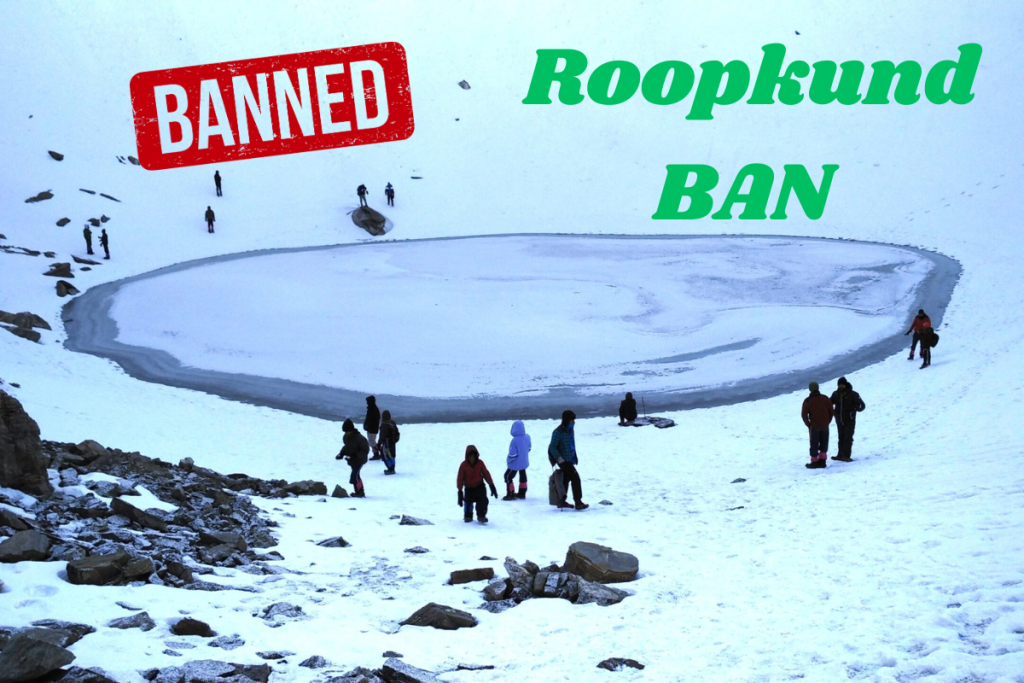The Roopkund trek, considered one of the most mysterious and thrilling treks of the Himalayas, has been banned by the Uttarakhand High Court. This ban has shocked many courageous nature lovers and trekking lovers. But why is the Roopkund trek banned? This blog will tell you about the real reasons behind this decision, its impact on the hiking community, and what you can still do to experience similar beauty with TrekkSpot.

What is the definition of why the Roopkund trek is banned?
Roopkund is a high-altitude glacier lake located in the Chamoli district of the Uttarakhand state of India. This trek attracted thousands of trekkers every year due to its mystery and natural beauty. This lake is famous for the hundreds of human skeletons found on the bottom, due to which it is named “Skeleton Lake.”
But in 2018, the Uttarakhand High Court banned trekking activities in Bugyal regions (alpine meadows), including Roopkund, citing severe environmental erosion. The main reasons for banning the Roopkund trek are
Environmental Damage: Continuous trekking activity was causing irreparable damage to the delicate ecosystem of alpine grasslands. Garbage waste, deforestation, and excessive tourism were damaging natural habitats.
Violation of forest laws: Many trekking companies and local operators were trekking without proper permission, causing violation of the critics of the Forest Protection Act and Wildlife Protection Act.
Irregular tourism: More people were coming to this sector than capacity. Camps of campers were growing rapidly without any environmental approval. Garbage disposal had become a serious problem.
Government orders: Based on reports and court decisions, the Uttarakhand government banned commercial trekking in these environment-sensitive areas to protect the environment.
The ban on the Roopkund trek was a warning. This reminded us that it is thrilling, but it should not come at the cost of nature. In Tracken, we believe in responsible tourism. Our goal is to help you investigate without leaving a negative effect.
Why ban the Roopkund trek? It’s a trending platform.
Many trekkers, influential people, and news portals have covered the ban on the Roopkund trek on various digital platforms. Two major sources where this theme is continuously trending are:
Instagram has become a center of sharing stories, updates, and environmental concerns for travel bloggers and trekkers.
Many nature-affected and conservation groups have explained why the Roopkund trek has been banned using Instagram. Some have posted photos of Bugyal grasslands before and after, which reflect environmental damage. They help in spreading visual awareness rapidly.
The official Instagram of the Traccspians also shares materials related to the trekking, including updates of the restricted trek. We believe that visualizing your audience on platforms like Instagram can lead to real changes.
Popular Instagram Trends:
Pictures of Roopkund before the ban.
Reel is discussing an alternative trek.
Educational material on ecotourism.
Instagram has made it possible to reach young trekkers who probably do not read news articles but follow visual stories. The more awareness we spread, the closer we will get to saving our natural treasures.
The results of Google Search have seen an increase in the number of such questions:
“Why is there a ban on the Roopkund trek?”
“The reason for the restriction on Roopkund” “Is Roopkund open for trekking?”
“The best option of Roopkund Trek”
The information available on Google includes both the official court order and the opinion of trekking agencies. Many trekking blogs and news websites have covered the issue deeply, providing legal details and environmental reports.
When you find a “Rupkund trek ban” on Google, the Trackespot appears as one of the major platforms that provide clear and informative answers. We ensure that our content is reliable, SEO-friendly, and educational.
The data from Google Trends also shows that the interest in the ban on the Roopkund trek increases in the pre-trading season (March to June) and then in October. This shows that trekkers are actively searching for updates and planning accordingly.
What the TrekkSpot suggests
Although the Roopkund trek has been banned, this does not mean that this adventure is over. In Tracken, we support the conservation of Roopkund and also recommend other luxurious but environmentally friendly options, such as
Ali Bedni Bugyal Trek: Alpine grasslands and magnificent views are found here too.
Brahmatal Trek: Another Himalayan gem with lakes and snowy peaks.
Dayara Bugyal Trek: One of the best grasslands allowed under the guidelines.
Durable trekking needs
The ban on the Roopkund trek was not just a legal action. This action was a message that we have to change our way of travel.
In TrekkSpot, we advocate these things:
Clean trekking (do not spread garbage).
Bio-incompatible camping equipment.
Limited number of groups.
Training of ecotourism to local guides.
The more we are aware, the more beautiful ways we will be able to preserve for the future. If the Roopkund trek is banned today, if we do not work with responsibility, then we can do the same tomorrow.
Conclusion
So, why is the Roopkund trek banned? The answer is simple but serious—to save the remaining part of nature. It was banned due to excessive tourism, damage to the environment, and careless trekking activities, which was completely appropriate. Although many people were disappointed, a comprehensive approach is more important—conservation of our mountains.
Platforms like Instagram and Google have helped spread awareness, and brands such as Traccspas continue their mission to promote responsible trekking.
Consider this a lesson for all of us. Let us trek not just for the view, but for its value. Let’s do hiking heartily and explore with respect.
TrekkSpot is here to guide you, inspire you, and help you choose better trekking options. Even if Roopkund is banned, the enthusiasm for trekking is alive—strong, clean, and sensible.